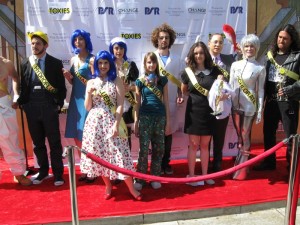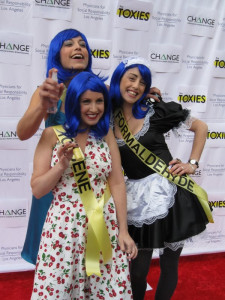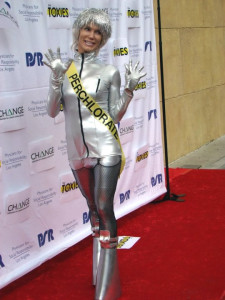 The Hummer limousine eased up to the curb in front of the Egyptian Theater March 3 in Hollywood for the First Annual Toxies Awards. Out stepped a rogue’s gallery of “bad actors” with names like Trichloroethylene, Hydrofluoric Acid and Toluene.
The Hummer limousine eased up to the curb in front of the Egyptian Theater March 3 in Hollywood for the First Annual Toxies Awards. Out stepped a rogue’s gallery of “bad actors” with names like Trichloroethylene, Hydrofluoric Acid and Toluene.
This was no ordinary awards show taking place just days before the more famous Academy Awards March 7 just down Hollywood Boulevard at the Kodak Theatre. These characters held more than just a brief fascination for the star struck; they were chemicals that had permeated almost every aspect of our society with the result being decidedly un-Hollywood: erectile dysfunction, breast cancer, autism and a whole host of some of the most terrifying medical maladies caused by many of 85,000 chemicals we commonly use.
But that’s not to say that some of these chemical bad actors weren’t hot. When a silver rocket girl with rocket boosters on her feet emerged from the limo with Perchlorate emblazoned on a sash across her gleaming body, all I could think of was missiles and fireworks and explosions, all of which Perchlorate plays a starring role in.
This was the toxin that had launched a thousand rockets. One of them was mine, as I was one of the first reporters in California to write about perchlorate, the rocket fuel oxidizer that has fouled groundwater from Simi Valley to the San Gabriel Valley and is delivered daily in perchlorate-tainted water from the Colorado River.
The silver fox playing Perchlorate looked suspiciously like an alien bot I’m quite familiar with — D-bot, also known as Denise Anne Duffield, my EnviroReporter.com editor and partner.
Duffield is also the associate director of one of the groups that helped produce this inaugural Toxies, Physicians for Social Responsibility-Los Angeles, or PSR-LA. Together with the CHANGE Coalition (Californians for a Healthy and Green Economy), PSR-LA has been battling to enact laws like the Green Chemistry Initiative as reflected in a 14 page report released to the press at the event called “Bad Actor Chemicals – Recipients of the 2010 Toxie Awards.”
The report looks at the challenges facing environmentalists in California:
In 2008, California launched the Green Chemistry Initiative, a coordinated, comprehensive strategy for fostering the development of information on the hazards posed by chemicals, ways to reduce exposure to dangerous substances, approaches that encourage cleaner and less polluting industrial processes, and strategies to encourage manufacturers to take greater responsibility for the products they produce. When an effective Green Chemistry program is in place in California, chemicals such as the ones highlighted here will be phased out, because of their toxic qualities, and will be replaced by substances or processes that are just as effective, cost-neutral and safer.
Unfortunately, there is a great deal of uncertainty about whether the Green Chemistry Initiative will be the robust program envisioned by the legislators who voted for it. The timing of this report coincides with the anticipated release, this spring, of a final draft of regulations that will implement the Green Chemistry program. The administrative law process that will put these rules into action provides opportunities to comment on them and to change them if they are insufficient. If it’s up to the people who peddle chemicals, who spend whatever it takes in terms of time and money in Sacramento to preserve the status quo, the regulations will be vague and weak.
Tough as it is trying to turn the tide of dangerous chemicals back, these environmentalists still maintain a sense of humor. Included in the media packet was a surgical mask with The Toxies emblazoned across it.
 PSR-LA’s close knit team produced a pop-culture friendly yet frighteningly fact-filled event with actors who clearly relished the roles. The wildly-costumed awards recipients strutted along the red carpet as cameras flashed and photographers jostled for the best shot. PSR-LA and the coalition’s “step and repeat” provided the thespians and performance artists the stage these here-to-fore voiceless chemicals never had before.
PSR-LA’s close knit team produced a pop-culture friendly yet frighteningly fact-filled event with actors who clearly relished the roles. The wildly-costumed awards recipients strutted along the red carpet as cameras flashed and photographers jostled for the best shot. PSR-LA and the coalition’s “step and repeat” provided the thespians and performance artists the stage these here-to-fore voiceless chemicals never had before.
“I am so happy to be here today,” Miss BPA said upon receiving her award. “I am a great estrogen impersonator and I love spending time with your children at such a tender age. Thank you all, especially to the Chemical Industry Council for using me in all of their products like baby bottles and Sippy cups, formula containers and metal food can linings. This [award] goes especially for those people who don’t like me like the state of Minnesota that banned me last year. It doesn’t really matter as long as I keep making money, the state of California has a lot of work for me. Thank you so so much. As long as I can make a profit, your health can take a back seat.”
 Buff and half naked NMP (N-methyl pyrrolidone) strutted his best Chippendale moves, which was appropriate since the industrial solvent makes frequent appearances as a paint stripper and graffiti remover. But actor Will Barker’s good looks couldn’t disguise the fact that NMP is a clear and present danger according to CHANGE’s report:
Buff and half naked NMP (N-methyl pyrrolidone) strutted his best Chippendale moves, which was appropriate since the industrial solvent makes frequent appearances as a paint stripper and graffiti remover. But actor Will Barker’s good looks couldn’t disguise the fact that NMP is a clear and present danger according to CHANGE’s report:
N-Methyl Pyrrolidone (NMP) is an industrial solvent used extensively in chemical processing, and now makes frequent appearances as a paint stripper and graffiti remover. NMP has been kicking around for decades – usually in supporting, character roles or as a ‘catalyst” in chemical mixtures whose other toxic ingredients got all the headlines.
In the 1990s, NMP made up 60% of certain photoresist mixtures used in the so-called ‘clean industry’ of semiconductor fabrication. NMP has recently come into his own as his reputation for reproductive and testicular toxicity has finally come out of the shadows. Currently, NMP is appearing as a graffiti remover.
A blue-haired trio of beautiful bad actors was comprised of Toluene, Formaldehyde and Phthalates. Played by a winning Iliana Carter, the Toxie winner Phthalate nevertheless has had a terrible reputation as a chemical castrator according to the report which says “Sperm density has declined 40% in the U.S. since World War II. Exposure to phthalates and flame retardants may be contributing to this trend. Men with high levels of phthalates in their urine tend to have low levels of sperm production; meanwhile, male rats exposed to even a single low dose of PBDE flame retardants while in the womb have significantly decreased sperm counts.”
 The report delves so deep into this family of chemical bad actors so that it would even cause a eunuch to pause:
The report delves so deep into this family of chemical bad actors so that it would even cause a eunuch to pause:
Phthalate represents a family of chemical bad actors who first entered the business in the 1920s. Five members of her family have been inducted into California’s Proposition 65 List for causing cancer. Her most prominent roles include softening the scene in PVC/vinyl products and making plastics more flexible and durable. She’s starred in children’s toys, food packaging, vinyl shower curtains, and numerous medical devices.
After being discontinued in some plastics, Phthalate is receiving widespread attention for her roles in fragrances, lotions, shampoos, nail polish, and cleaning products. As softening and sweet-smelling as she may appear to be, Phthalate’s performances in these roles brings along cancer and reproductive harm, including birth defects of the penis and other indications of demasculinization. That is some body of work.
Some bodies would be more accurate. The chemicals were all so attractive that it ironically spoke to how untold numbers of substances are marketed to us in products designed to make us feel more beautiful, clean and happy. In reality, the coalition says, many of these bad actor chemicals are actually making us more stupid, cause cancer, deplete the ozone layer and deform our sexual organs. California consumers have inadvertently laid upon the chemical industry’s seductive casting couch and the result is that everyone gets screwed, like it or not.
But who cares if we’re having fun as Lead, played uproariously by Juan Rodriguez, pointed out as he accepted the Lifetime Achievement Award in Harm over the objections of an equally hilarious Mercury, as channeled by Edward Enriquez:
“Thank you, thank you; I resemble those comments,” Lead laughed gripping his award. “I’d like to say that I’ve been around for a long long time. I’ve seen a lot of things. I’ve poisoned a whole lot of people and I’d like to say ‘thank you for still keeping me around and for this Lifetime Achievement Toxie award.’ I love shiny things. When I was banned from gasoline and paint, I thought my life was over. My legacy still lives on thanks to weak regulations and substandard housing that doesn’t get cleaned up right by landlords and that are some people still not accepting that even my very small performances can cause some intellectual dommage [damage] – that’s French. I forgot what else I was going to say. Thank you. Thank you for the award and I hope to be around for a very very long time.”
Reporters are supposed to be an impartial lot yet are often accused of bias. My experience is no different especially chronicling the environmental woes of our day. But while I generally dismiss the notion of bias, I will confess that two of the Toxies, trichloroethylene and perchlorate, hold a tender place in my lung tissues.
Especially perchlorate. Back in 2002, when few Californians had ever heard of the fiery chemical, my LA Weekly article “Earthly Secrets” forced the county of Ventura to test the groundwater of a proposed Washington Mutual development at Ahmanson Ranch. The pressure to test came from the fact that the ranch sits adjacent the astronomically polluted Santa Susana Field Laboratory, commonly known as Rocketdyne. When the tests came back, I espied the tell-tale reading of perchlorate in the study, the finding of which began the unraveling of the development as predicted by my Ventura County Reporter cover story “Rocketdyne Ranch – Will the Ahmanson development tank over toxic trouble?”
WaMu’s project did tank and today the ranch is parkland thanks mostly to perchlorate, which the CHANGE report notes is quite a problem in the Golden State:
Perchlorate’s exciting roles as an oxidizer in rocket fuel, explosives, airbags and fireworks sometimes makes viewers forget about her more insidious role as a contaminant in drinking water. Her performances as a bad actor chemical interfere with iodide uptake into the thyroid gland, causing hypothyroidism in mothers, and negatively impacting proper childhood development such as decreased learning capability.
While no one denies Perchlorate’s ability to light up the sky and screen, she’s been known to make her way into the drinking water sources for over 20 million Californians, and into the groundwater or soil of 43 states. Unfortunately, her “special effects” aren’t contained, and are toxic to communities who unwillingly catch her performances in their drinking water!
While that seems off-putting, it is notable that this chemical was largely responsible for sinking the Ahmanson Ranch development and contributing to questions about the stalled Runkle Canyon development project that KB Home and Lennar hope to build adjacent to the ranch and Rocketdyne. So it could be argued that I have a soft spot for Perchlorate even though she was quite the firecracker when interviewed on film by PSR-LA’s Ana Mascareñas, the Toxies project coordinator.
After the awards ceremony, CHANGE coalition representatives took to the stage to give the not-so-pretty picture on chemical policy in California. PSR-LA Executive Director Martha Dina Arguello said, “Today, this event is about a message that we want to send to the Governor, that we want strong regulations, that we want to kick these bad actors out of California.” Ansje Miller, Policy Director for the Center for Environmental Health and Coordinator of the CHANGE Coalition, spoke about the Coalition and it’s connection to a national effort, SAFER, or State Alliance for Federal Reform of Chemicals Policy.
 Toxics Advocate and Staff Attorney for Environment California, Pam Paltz, discussed the Green Chemistry policy initiative, which would not only help protect public health from harmful toxic chemicals, but could lead to innovation in creating green jobs in California. Paltz challenged Governor Schwarzenegger, “So this is your opportunity, Mr. Governor, to be the superhero that you’ve often said you hoped to be, to ensure your green legacy for California, and rid us of bad actor chemicals.”
Toxics Advocate and Staff Attorney for Environment California, Pam Paltz, discussed the Green Chemistry policy initiative, which would not only help protect public health from harmful toxic chemicals, but could lead to innovation in creating green jobs in California. Paltz challenged Governor Schwarzenegger, “So this is your opportunity, Mr. Governor, to be the superhero that you’ve often said you hoped to be, to ensure your green legacy for California, and rid us of bad actor chemicals.”
In all, the Toxies were a truly fascinating combination of education and entertainment about toxic chemicals that are otherwise no laughing matter. Kudos to PSR-LA, the CHANGE Coalition, Jana Díaz Juhl and the talented team they all amassed. Patricia Mateos Ballestero’s headshots of the Bad Actors were particularly inspired.
I eagerly await next year’s Toxies show, where it’s rumored that some chemicals – such as DDT – will receive post-humus awards. While I’d miss seeing some of these Bad Actors’ swaggering shenanigans, the sheer number of unregulated chemicals guarantees there will be others to take their places. Or perhaps California’s Green Chemistry Initiative will produce its own show stopping performance to protect public health from toxic chemicals.
The First Annual Toxies – Related Materials and Links:
Photos from The First Annual Toxie Awards
Video from The First Annual Toxie Awards
Bad Actor Chemicals Report — Californians for a Healthy & Green Economy
The CHANGE Coalition
Physicians for Social Responsibility – Los Angeles












Let’s retire those “Bad Actor Chemicals!” Follow this link to take action and tell your representatives that we want safer alternatives to Toxies awardees http://bit.ly/b2bpdr
Thank you PSR and the wonderful reporting of Enviroreporter Michael Collins. It is very encouraging to see the younger generation carrying the torch to inform and educate others about these poisons in our midst. This method of teaching is brilliant–very visual with important lessons.